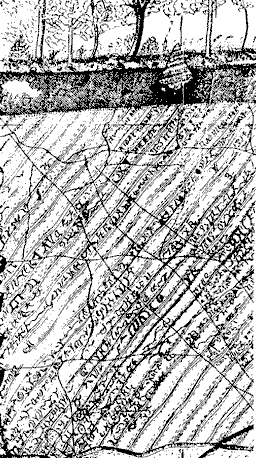 |
Science Frontiers ONLINE No. 97: Jan-Feb 1995 |
|
|
The "inscribed wall" at chatata, tennessee
One of our favorite anomalies over the years has been the ancient "inscribed wall" at Chatata, near Cleveland, in Bradley County, Tennessee. The above quotation marks are intended to warn the reader that said wall may not be man-made, and its inscriptions may be natural rather than artificial.
 An old drawing of a section of the "inscribed wall" at Chatata, TN. Note the triangular marker stone projecting above ground level. |
The wall was originally almost completely buried. It attracted attention only because its course was marked on the surface by stones projecting from the ground every 25-30 feet over a gently curving arc about 1,000 feet long. One of these surface stones seemed to be inscribed with strange symbols. Excavations, supported at first by the Smithsonian Institution, revealed a 3-ply sandstone wall-like structure seemingly cemented together by a reddish mortar. Splitting the sandstone sheets revealed diagonal rows of markings like those illustrated.
At first, both wall and inscriptions were proclaimed to be artificial. More recent studies by geologists point to natural origins for the wall, the mortar, and even the inscriptions themselves. The latter may be no more than the burrows of mollusks. This interpretation does make sense because the so-called inscriptions were almost completely covered by the "mortar" -- hardly a good way to convey messages! Also, the inscriptions themselves do not really look regular enough to be man-made. For these and other reasons, the Chatata wall now seems more of a geological curiosity rather than an archeological anomaly.
Nevertheless, at least two nagging questions remain:
- Why were there regularly placed stones on the surface over the wall?
- Early investigators also reported seeing inscriptions of animals, the swastika, the serpent symbol, and other recognized Indian symbology. Whatever happened to these inscriptions?
(Wirth, Diane E.; "An Ancient Wall at Chatata, Bradley County, Tennessee, Ancient American, 1:20, September/ October 1994. Also: Rawson, A.L.; "The Ancient Inscription at Chatata, Tennessee," American Antiquarian, 14: 221, 1892. Reproduced in our handbook: Ancient Man. To order see here.)
Comment. An incredible variety of complex markings occur on rock surfaces. Often human origins have been proclaimed only to yield to natural explanations. See ESX6 in Neglected Geological Anomalies. Ording information at the above WWW address.